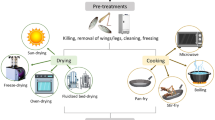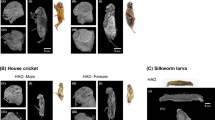Abstract
Insects represent a sustainable but under-exploited food resource partly due to the chitin-containing exoskeleton and also the high lipid content that hamper the production of food ingredients. Here we present dry fractionation technology for upgrading house crickets (Acheta domesticus) and yellow mealworm larvae (Tenebrio molitor) by extraction with supercritical carbon dioxide followed by separation to fine and coarse fractions by air classification. The defatted insects contained 73–79% crude protein that was partially fractionated by air classification to protein-enriched fractions containing less chitin. In addition to the significant difference in the coarse mouthfeel between the fine and coarse fractions, the fine fraction of crickets was perceived saltier and more intense in flavour, and the fine fraction of mealworms having more meat-like flavour than the coarse fraction. Thus, it seems that the fractionation process has a clear impact on the texture (coarseness), but the flavour characteristics could be varied according to the insect variety. Overall, the dry fractionation technology holds promising prospects for the production of insect-based food ingredients that are modified in their chitin content and flavour intensity, does not contain identifiable anatomical parts, and thus, could better meet consumer acceptance.







Similar content being viewed by others
References
Bodenheimer FS (1951) Insects as human food; a chapter of the ecology of man. Dr. W. Junk Publishers, The Hague, p 352
Rumpold BA, Schlüter O (2015) Insect-based protein sources and their potential for human consumption: nutritional composition and processing. Anim Front. doi:10.2527/af.2015-0015
DeFoliart GR (1999) Insects as food: why the western attitude is important. Annu Rev Entomol 44:21–50. doi:10.1146/annurev.ento.44.1.21
Sun-Waterhouse D, Waterhouse GIN, You L et al (2016) Transforming insect biomass into consumer wellness foods: a review. Food Res Int. doi:10.1016/j.foodres.2016.10.001
van Huis A (2013) Potential of insects as food and feed in assuring food security. Annu Rev Entomol 58:563–583. doi:10.1146/annurev-ento-120811-153704
van Huis A (2015) Edible insects contributing to food security? Agric Food Secur 4:20. doi:10.1186/s40066-015-0041-5
Tan HSG, Verbaan YT, Stieger M (2017) How will better products improve the sensory-liking and willingness to buy insect-based foods? Food Res Int 92:95–105. doi:10.1016/j.foodres.2016.12.021
Kramer KJ, Hopkins TL, Schaefer J (1995) Applications of solids NMR to the analysis of insect sclerotized structures. Insect Biochem Mol Biol 25:1067–1080. doi:10.1016/0965-1748(95)00053-4
Finke MD (2007) Estimate of chitin in raw whole insects. Zoo Biol 26:105–115. doi:10.1002/zoo
Finke MD (2002) Complete nutrient composition of commercially raised invertebrates used as food for insectivores. Zoo Biol 21:269–285. doi:10.1002/zoo.10031
Nowak V, Persijn D, Rittenschober D, Charrondiere UR (2016) Review of food composition data for edible insects. Food Chem 193:39–46. doi:10.1016/j.foodchem.2014.10.114
Yi L, Lakemond CMM, Sagis LMC et al (2013) Extraction and characterisation of protein fractions from five insect species. Food Chem 141:3341–3348. doi:10.1016/j.foodchem.2013.05.115
Schutyser MAI, Van Der Goot AJ (2011) The potential of dry fractionation processes for sustainable plant protein production. Trends Food Sci Technol 22:154–164. doi:10.1016/j.tifs.2010.11.006
Sibakov J (2014) Processing of oat dietary fibre for improved functionality as a food ingredient, vol 67. VTT Science, Espoo, p 166
Sipponen MH, Pihlajaniemi V, Vainio H et al (2016) Integrating the opposites of biofuel production: absorption of short-chain alcohols into oleaginous yeast cells for butanol recovery and wet-extraction of microbial oil. Green Chem 18:2775–2781. doi:10.1039/C5GC03008K
Suutari M, Liukkonen K, Laakso S (1990) Temperature adaptation in yeasts: the role of fatty acids. J Gen Microbiol 136:1469–1474. doi:10.1099/00221287-136-8-1469
Jaakola S, Vahvaselkä M, Laakso S (2005) Effect of CLA on the cellular lipids of Saccharomyces cerevisiae. JAOCS, J Am Oil Chem Soc 82:745–748. doi:10.1007/s11746-005-1137-7
Janssen RH, Vincken J-P, van den Broek LAM et al (2017) Nitrogen-to-protein conversion factors for three edible insects: tenebrio molitor, Alphitobius diaperinus and Hermetia illucens. J Agric Food Chem 65:2275–2278. doi:10.1021/acs.jafc.7b00471
Osborne TB, Mendel LB (1919) The nutritive value of the wheat kernel and its milling products. J Biol Chem 37:557–601
Arroyo-Begovich A, Cárabez-Trejo A, Ruíz-Herrera J (1980) Identification of the structural component in the cyst wall of Entamoeba invadens. J Parasitol 66:735–741
Lawless HT, Heymann H (2010) Sensory evaluation of food principles and practises, descriptive analysis, 2nd edn. Chapman & Hall/Aspen Publishers Inc., Gaithersburg
Ramos-Bueno RP, González-Fernández MJ, Sánchez-Muros-Lozano MJ et al (2016) Fatty acid profiles and cholesterol content of seven insect species assessed by several extraction systems. Eur Food Res Technol 242:1471–1477. doi:10.1007/s00217-016-2647-7
Simopoulos AP (2002) The importance of the ratio of omega-6/omega-3 essential fatty acids. Biomed Pharmacother 56:365–379. doi:10.1016/S0753-3322(02)00253-6
Montanari L, Fantozzi P, Snyder JM, King JW (1999) Selective extraction of phospholipids from soybeans with supercritical carbon dioxide and ethanol. J Supercrit Fluids 14:87–93. doi:10.1016/S0896-8446(98)00110-7
Tanaka Y, Sakaki I, Ohkubo T (2004) Extraction of phospholipids from salmon roe with supercritical carbon dioxide and an entrainer. J Oleo Sci 53:417–424. doi:10.5650/jos.53.417
Soh L, Zimmerman J (2011) Biodiesel production: the potential of algal lipids extracted with supercritical carbon dioxide. Green Chem 13:1422–1429. doi:10.1039/C1GC15068E
Mariod AA (2013) Insect oil and protein: biochemistry, food and other uses: review. Agric Sci 4:76–80
Vincent JFV, Wegst UGK (2004) Design and mechanical properties of insect cuticle. Arthropod Struct Dev 33:187–199. doi:10.1016/j.asd.2004.05.006
Levy-Sakin M, Scherzer-Attali R, Gazit E (2012) Modifiers of protein aggregation—from nonspecific to specific interactions. In: Schweitzer-Stenner R (ed) Protein peptide folding, misfolding, non-folding. John Wiley & Sons Inc, Hoboken, pp 441–478
Payne CLR, Scarborough P, Rayner M, Nonaka K (2016) A systematic review of nutrient composition data available for twelve commercially available edible insects, and comparison with reference values. Trends Food Sci Technol 47:69–77. doi:10.1016/j.tifs.2015.10.012
van Straaten M, Goulding D, Kolmerer B et al (1999) Association of kettin with actin in the Z-disc of insect flight muscle. J Mol Biol 285:1549–1562. doi:10.1006/jmbi.1998.2386
Bullard B, Leonard K (1996) Modular proteins of insect muscle. Adv Biophys 33:211–221. doi:10.1016/0065-227X(96)81676-5
Acknowledgements
Ilkka Kajala is acknowledged for assistance in air classification trials and Heli Nygren for amino acid analysis. This research did not receive any specific grant from funding agencies in the public, commercial, or not-for-profit sectors.
Author information
Authors and Affiliations
Corresponding author
Ethics declarations
Conflict of interest
None.
Compliance with ethics requirements
The sensory evaluation was done with a trained human panel with 10 assessors at the sensory laboratory of VTT, which fulfils the requirements of the ISO standards (ISO 2005 and 2007). The panelists were informed about the source of the samples prior to the analysis. The samples were produced with food-grade facilities. The sensory evaluation was done with taste and spit assay, i.e. the samples were not swallowed.
Electronic supplementary material
Below is the link to the electronic supplementary material.
Rights and permissions
About this article
Cite this article
Sipponen, M.H., Mäkinen, O.E., Rommi, K. et al. Biochemical and sensory characteristics of the cricket and mealworm fractions from supercritical carbon dioxide extraction and air classification. Eur Food Res Technol 244, 19–29 (2018). https://doi.org/10.1007/s00217-017-2931-1
Received:
Revised:
Accepted:
Published:
Issue Date:
DOI: https://doi.org/10.1007/s00217-017-2931-1




